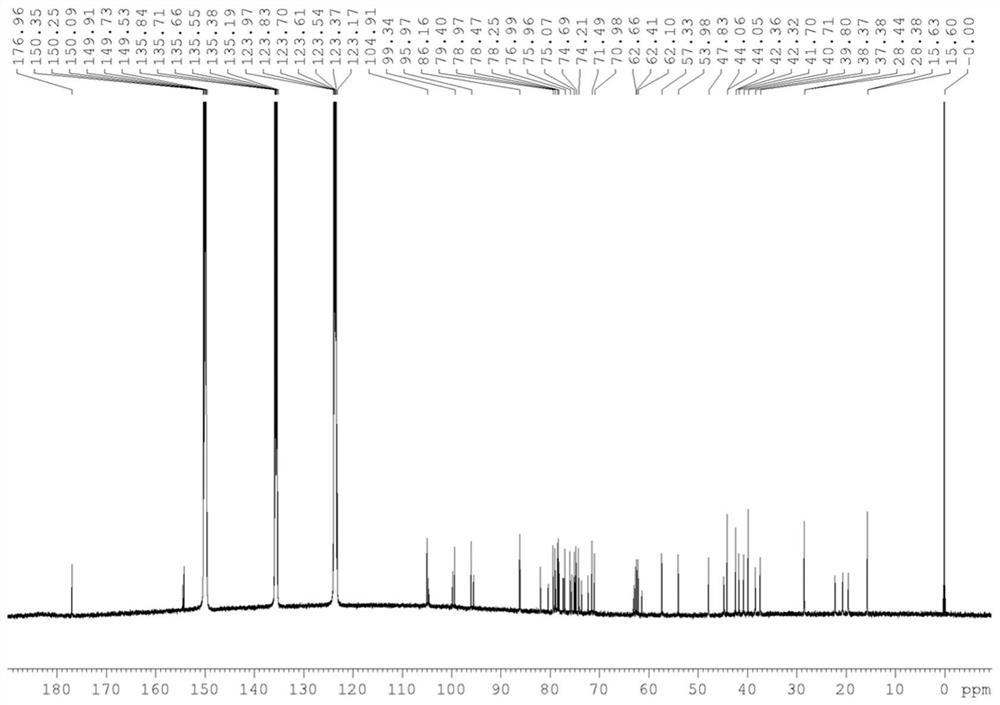Terpene glycoside derivatives and uses thereof
A technology of terpene glycosides and terpene glycosides, applied in the field of terpene glycosides, can solve problems such as bad taste attributes, preventing widespread adoption, etc.
- Summary
- Abstract
- Description
- Claims
- Application Information
AI Technical Summary
Problems solved by technology
Method used
Image
Examples
Embodiment 1
[0105] Example 1: Generation of mono-β-1,4-glucosylated terpene glycoside compounds (compounds I and II) starting from rubusoside by methods according to some morphologies proposed herein
[0106] Rubusoside (1 g) and cellobiose (1 g) were dissolved in 10 ml of NaOAc-HOAc (pH=5.0, 0.2 M, 5 mL) buffer at room temperature. Subsequently, 200 mg of cellulase (Aladdin) was added to the mixture. The enzyme-containing mixture was then heated to 37°C and incubated at 37°C for 24 hours to allow the transglucosidation reaction to proceed to produce a At least one glucosylated terpene glycoside of a single glucosyl residue linked to an glycoside. The reaction was terminated by inactivating the cellulase by incubating the reaction mixture at 100°C for 30 minutes.
[0107] The resulting reaction mixture was analyzed by UPLC-UV, and the mixture was identified to contain glucosylated terpene glycosides with a single glucosyl residue linked to the terpene glycoside via a β-1,4 glucosidic bo...
Embodiment 2
[0110] Example 2: Sensory properties of compositions comprising compounds I and II
[0111] According to the method described in Example 1, a composition comprising a mixture of a compound of formula I and a compound of formula II in a ratio (w / w) of 2:1 was produced. The composition was dissolved in (i) a 4% w / w solution of sucrose, or (ii) a 0.02% w / w solution of 95% steviol glycosides. A panel of 25 trained individuals rated them on a scale of -5 to 5 (-5 being no effect, 5 being very strong effect, 0 being the strength of a reference aqueous solution containing (i) 4% w / w sucrose solution or (ii) 0.02% w / w of 95% steviol glycoside solution) to evaluate the taste characteristics (sweet, licorice and sweetness residue) of the test solution. The results are shown in the table below.
[0112]
[0113] These data show that a composition comprising Compounds I and II in a 2:1 ratio significantly enhanced the sweetness intensity of a 4% w / w sucrose solution with and without ...
Embodiment 3
[0114] Example 3: Sensory properties of compositions comprising at least one mono-β-1,4-glucosylated terpene glycoside proposed herein
[0115]Compositions comprising at least one glucosylated terpene glycoside can be produced according to the method described in Example 1. The composition can be dissolved in (i) water, or (ii) 4% w / w sucrose solution, or (iii) 7% (w / w) invert sugar plus 0.15% citric acid (w / w ) solution, wherein the final concentration of the composition in the solution ranges from 0 to 1000 ppm. Corresponding control solutions will also be produced, respectively (i) 1.5%, or (ii) 4% w / w sucrose, or (iii) 7% (w / w) invert sugar plus 0.15% citric acid (w / w) solution. A panel of 10 experts will use the 3-Alternative Forced Choice (3-AFC) or sweetness intensity scale to evaluate the difference between the test composition solution and the sucrose solution. All samples will be tested blind in random order.
PUM
 Login to View More
Login to View More Abstract
Description
Claims
Application Information
 Login to View More
Login to View More - R&D
- Intellectual Property
- Life Sciences
- Materials
- Tech Scout
- Unparalleled Data Quality
- Higher Quality Content
- 60% Fewer Hallucinations
Browse by: Latest US Patents, China's latest patents, Technical Efficacy Thesaurus, Application Domain, Technology Topic, Popular Technical Reports.
© 2025 PatSnap. All rights reserved.Legal|Privacy policy|Modern Slavery Act Transparency Statement|Sitemap|About US| Contact US: help@patsnap.com



